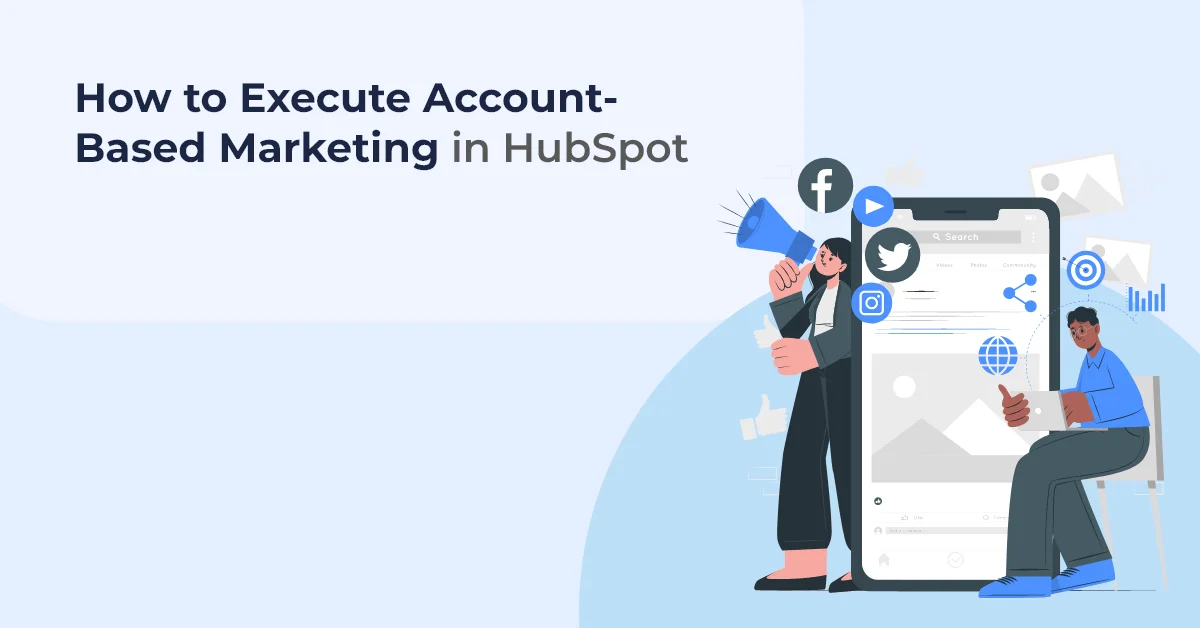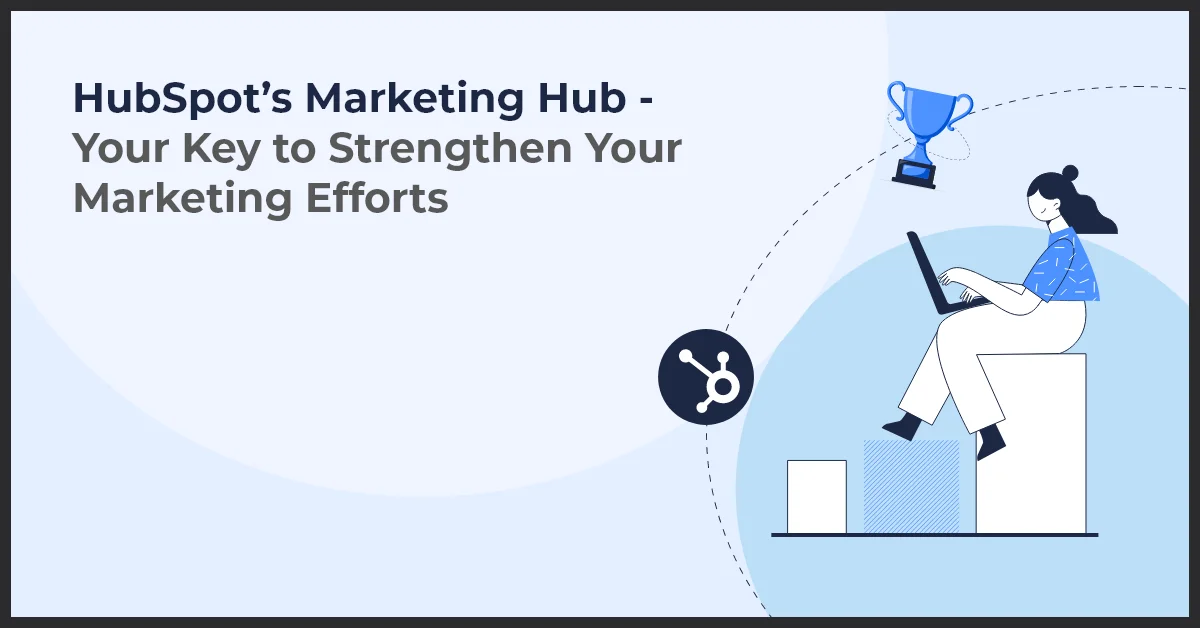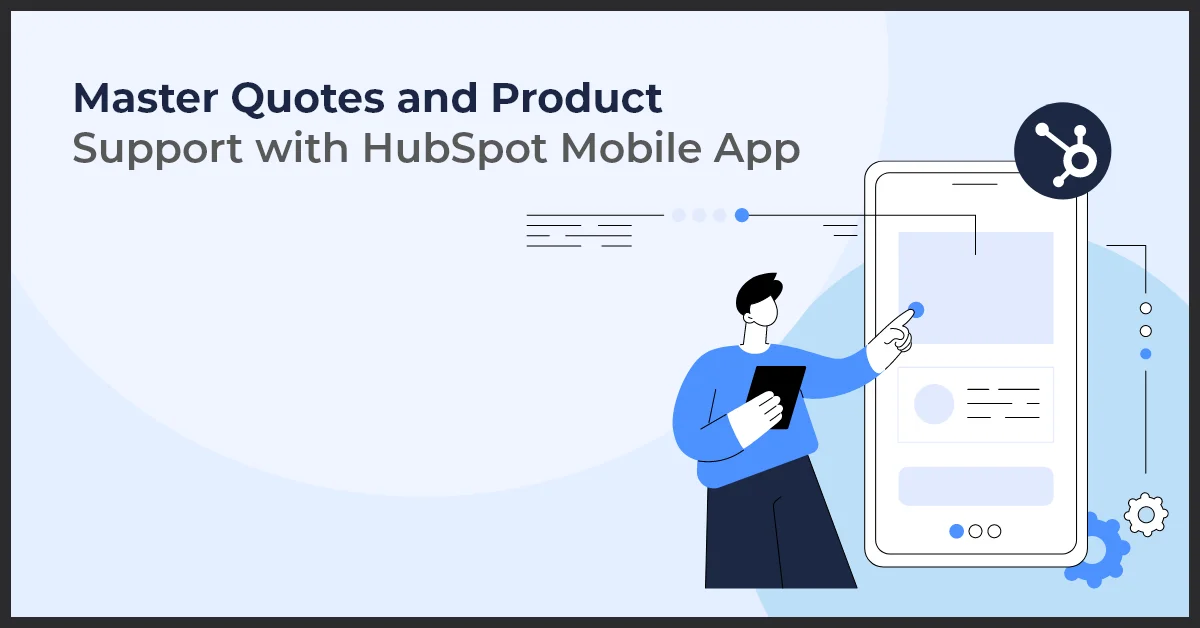How to Execute Account-Based Marketing in HubSpot

Published on: September 9, 2022
Updated on: July 05, 2024
732 Views
- HubSpot
17 min read
No matter how much time you spend in digital marketing, one thing may always break your flow—unqualified leads. An unqualified lead is an individual who has not been nurtured enough through your sales process. They might be looking for a service or product that you offer but might actually be unsure about what you offer. They might not even have determined a price range yet.
There is only one way to close these unqualified leads, and that is with account-based marketing or ABM. This means selling directly to your target audience. You can do this with the help of your marketing and sales team while delighting your customers and increasing your revenue. It is a win-win for everyone!
Understanding Account-Based Marketing
ABM is a hyper-personalized marketing practice that aligns your sales and marketing efforts, creating tailored buying experiences for mutually-identified key prospects. This can improve the deal closing rate by 67%. It is all about identifying and selling to the highest value customers.
Remember those unqualified leads that we mentioned above?
ABM works to avoid them, targeting high-quality accounts and treating them as individual markets. You can see that increased ROI as an effective ABM strategy can help uplift the revenue of your business by 208%. This is only possible if you:
- Personalize buyer journeys
- Create tailored solutions
- Target highly valued accounts
ABM and Inbound Marketing: Two Sides of the Same Coin?
First and foremost, both account-based marketing and inbound marketing rely on a thorough understanding of your target market. You need to understand your buyer personas, your company's strategic keywords, the content themes you should generate, and the communication channels you should employ.
Both ABM and inbound marketing emphasize providing a pertinent experience throughout the buying funnel, and ABM can frequently speed up this decision-making process when an inbound strategy is already in place.
Since both strategies aid in fostering client loyalty and happiness, ABM can further capitalize on this retention by concentrating on particular accounts and their unique realities. Inbound marketing can help you attract the right customers and then account-based marketing will accelerate the buying decision process, ensuring a relevant and personalized experience.
Eventually, inbound marketing and ABM will together enable you to close significant accounts for your company. You may create a more solid and successful strategy if you see how the two techniques complement each other.
How to Implement ABM with HubSpot
To implement ABM correctly, you need the right software. HubSpot is one of the best choices as it includes all of ABM’s intuitive tools that can help create a seamless buying experience for most of your high-paying customers.
With HubSpot, you can carry out ABM strategies in the most efficient and integrated way. And if you are a little blurry on how to do it, you are at the right place. We will break down the entire process in easy steps:
1. Activate ABM Tools
To activate these tools and features, you will need to be a super admin or user with account permissions. Thus, you can add target accounts, view prospects in the prospecting tool, or import target accounts through an integration with a third-party product such as LinkedIn Sales Navigator, ZoomInfo, Bombora, Terminus, or RollWorks.
2. Update ABM Information
There are some default properties that are used in the ABM dashboard, reports, list, and target audience. Here are some of the common properties that you need to update regularly:
Contact Properties
- Buying Role: The buying role identifies the function that a contact performs during the sales process. In addition to having multiple roles, contacts can also share a position with another contact. Although the default values cannot be removed, you can update this field to include new buying roles.
Company Properties
- Target account: This is a single checkbox attribute that defines the businesses that you are promoting and selling to as part of your ABM strategy. You can set the target account property value of a company record to True to mark a company record as a target account in HubSpot.
- Tier for ideal customer profile: In three levels, this shows how closely a company fits your ideal customer profile. Tier 1 businesses should be a perfect fit for you; however, Tier 3 businesses may be less important and barely acceptable. Additionally, you can modify this parameter to fit your corporate philosophy.
Note: You can update ABM properties using workflows. You can also segment your lists using workflows and third-party integrations, and adjust an account's ad and other targeting based on engagement, intent, and score.
Target Particular Accounts
You have access to the Target Accounts Home after your ABM tools are activated. HubSpot suggests businesses as the best accounts you can choose from.
- Create company lists: You can create contact and company lists based on ABM contact and business properties. These lists may be used to segment your contacts, create target audiences for your advertisements, send promotional emails, and create smart content for your website.
- Create ads for target accounts: You can create a company list audience to automatically sync businesses from your target accounts or a certain company profile tier to the matching audience in LinkedIn if you've linked your LinkedIn Ads account to HubSpot.
Work With Target Accounts
You must navigate to your target account's home to see your target account. You can monitor target account behavior while identifying new accounts to target, and it helps you maintain track of the account you wish to work on.
- Use account overview: You must have a HubSpot Sales Hub Professional or Enterprise seat to view the account overview for a company record. If so, you can access the overview for company records in Salesforce, the right panel of a company record, and your target accounts home.
- Use playbooks: You can choose the Account-based selling playbook type as a default template when developing playbooks. Make the template your own to suit your company's sales strategy. Then, as they work with a contact record or a transaction record, this playbook will serve as advice for your team members when they talk with prospects and clients.
- Use integrations: Slack is a well-liked HubSpot integration. This enables you to call and push data directly from HubSpot. This includes doing things like using the Slack command /hs-report-company to access metrics for a selected account. You can also utilize HubSpot workflows to create deals and Slack channels for your business.
Use Reports to Analyze Target Accounts
HubSpot has a library of powerful dashboards and insights based on ABM attributes; it is ideal for running ABM programs. You can use these to evaluate current ABM initiatives, use data to improve ABM tactics and identify solutions to sales and marketing problems.
Fundamentals of Account-Based Marketing (ABM)
A. Defining and segmenting target accounts
In order to successfully implement an account-based marketing strategy in HubSpot, it is crucial to define and segment your target accounts. This involves identifying the key accounts that are most valuable to your business and aligning your marketing efforts towards them.
Segmentation allows you to personalize your messaging and tailor your content to the specific needs and characteristics of each target account. By understanding the unique pain points and challenges of each account, you can create a more compelling and targeted marketing approach.
B. Creating personalized content for target accounts
One of the main pillars of account-based marketing is creating personalized content for your target accounts. This involves developing messaging, offers, and assets that directly address the specific pain points and goals of each account.
HubSpot provides various tools and features that can help you create personalized content, such as dynamic content modules and smart content. These enable you to customize your messaging based on the information you have about each target account, such as industry, company size, or previous interactions.
C. Implementing targeted outreach and engagement strategies
Targeted outreach and engagement strategies play a crucial role in account-based marketing. Once you have defined your target accounts and created personalized content, it's important to engage with them through targeted communications and touchpoints.
HubSpot offers several features that can assist you in implementing these strategies, such as email sequences, personalization tokens, and CRM integrations. These tools allow you to automate and personalize your outreach efforts, ensuring that your messages resonate with your target accounts and drive meaningful interactions.
D. Measuring success and tracking ROI in ABM campaigns
Measuring the success and tracking the ROI of your account-based marketing campaigns is essential to understand the impact of your efforts and make data-driven decisions.
HubSpot provides robust analytics and reporting features that enable you to track and measure the performance of your ABM campaigns. You can monitor key metrics such as engagement rates, conversion rates, and revenue generated from target accounts.
By analyzing these metrics, you can assess the effectiveness of your strategies, identify areas for improvement, and optimize your ABM campaigns to maximize ROI.
Best Practices for ABM with HubSpot
Implementing an account-based marketing (ABM) strategy in HubSpot can greatly enhance your marketing efforts and drive meaningful results. To make the most out of this powerful tool, here are some best practices to keep in mind:
A. Developing a comprehensive ABM plan in HubSpot
Before diving into your ABM campaigns, it's crucial to develop a well-defined plan that aligns with your marketing goals. Start by identifying your target accounts and creating detailed buyer personas. This will help you tailor your messaging and content to resonate with your ideal customers.
B. Aligning marketing and sales teams for ABM success
An effective ABM strategy requires close collaboration between your marketing and sales teams. They must work together to identify high-value accounts, create personalized content, and align their efforts to deliver a seamless customer experience. Regular communication and shared goals are key to achieving ABM success.
C. Personalization and customization tips for ABM in HubSpot
Personalization is the cornerstone of ABM. Leverage HubSpot's powerful segmentation capabilities to tailor your messages and content to specific accounts or individuals. Use dynamic content, personalized landing pages, and targeted emails to engage your audience on a deeper level and increase your conversion rates.
D. Leveraging HubSpot's automation features for ABM
HubSpot offers a range of automation features that can streamline your ABM efforts. Take advantage of workflow automation to nurture leads, set up trigger-based emails, and automate follow-up tasks. This will save time, improve efficiency, and ensure that no lead falls through the cracks.
By following these best practices and leveraging the full power of HubSpot, you can supercharge your ABM campaigns and achieve remarkable results. Stay tuned for our next section on successful ABM campaigns in HubSpot!
Successful ABM Campaigns in HubSpot
Account-Based Marketing (ABM) has become an increasingly popular strategy for companies looking to personalize their marketing efforts and target key accounts. With the help of HubSpot, implementing successful ABM campaigns has never been easier. Here, we will explore some case studies, a step-by-step guide, and examples of effective ABM campaigns in HubSpot.
A. Case studies of companies using ABM in HubSpot
Real-life examples can provide valuable insights into the implementation and success of ABM campaigns in HubSpot. These case studies showcase how companies have leveraged HubSpot's capabilities to drive personalized and targeted marketing to engage their key accounts.
B. Step-by-step guide to setting up an ABM campaign in HubSpot
Implementing an ABM campaign in HubSpot may seem intimidating at first, but with this step-by-step guide, you can confidently navigate through the process. From identifying target accounts to segmenting your audience and creating personalized content, this guide will walk you through the necessary steps to launch a successful ABM campaign in HubSpot.
C. Examples of effective ABM campaigns in HubSpot
Examining real examples of successful ABM campaigns can provide inspiration and ideas for your own strategies. Discover how companies have utilized HubSpot's features, such as personalized email workflows, targeted ads, and predictive lead scoring, to achieve remarkable results and foster strong connections with their target accounts.
ABM Implementation with HubSpot's CRM
A. How HubSpot's CRM enhances ABM implementation
HubSpot's CRM is a powerful tool that can greatly enhance your ABM implementation. With the CRM, you can easily manage and organize your target account data, allowing you to efficiently track and monitor your ABM campaigns.
The CRM provides a centralized database where you can store all relevant information about your target accounts. This includes contact details, interactions, purchase history, and more. By having all this information in one place, you can easily gain insights into your target accounts and tailor your marketing efforts accordingly.
B. Integration of ABM strategies with HubSpot's CRM features
HubSpot's CRM seamlessly integrates with your ABM strategies, allowing you to create personalized and targeted campaigns for your key accounts. You can leverage the CRM's segmentation and list management features to easily categorize your target accounts and tailor your messaging based on their specific needs and preferences.
Furthermore, the CRM's automation capabilities enable you to automate various aspects of your ABM campaigns. You can set up automated workflows to deliver personalized content, trigger follow-up actions based on specific actions taken by your target accounts, and nurture leads throughout their buyer's journey.
C. Benefits of using HubSpot's CRM for ABM analytics and reporting
One of the major benefits of using HubSpot's CRM for ABM is its robust analytics and reporting capabilities. The CRM provides comprehensive insights into the performance of your ABM campaigns, allowing you to measure key metrics and track the success of your efforts.
You can easily create custom reports and dashboards within the CRM to visualize key ABM metrics such as engagement rates, conversion rates, and revenue generated from your target accounts. By analyzing this data, you can identify areas of improvement, optimize your campaigns, and make data-driven decisions to drive ABM success.
ABM Analytics and Reporting in HubSpot
Measuring and tracking ABM campaign performance in HubSpot
Implementing an account-based marketing (ABM) strategy in HubSpot allows you to measure and track the performance of your ABM campaigns effectively. With HubSpot's robust analytics capabilities, you can gain valuable insights into the success of your ABM efforts and make data-driven decisions to optimize your strategy.
HubSpot provides various metrics and key performance indicators (KPIs) to help you evaluate the effectiveness of your ABM campaigns. By closely monitoring these metrics, you can understand engagement levels, target account progression, and overall campaign performance.
Analyzing ABM metrics and KPIs in HubSpot's reporting tools
HubSpot's reporting tools offer a comprehensive view of your ABM metrics and KPIs, allowing you to analyze the performance of your campaigns in-depth. With customizable dashboards and visualizations, you can easily visualize data trends and identify areas for improvement.
Some essential ABM metrics and KPIs you can track in HubSpot include:
- Account engagement: Measure the level of engagement from target accounts, including email open rates, click-through rates, and website visits.
- Account progression: Track the movement of target accounts through different stages of the buyer's journey, such as lead to marketing qualified lead (MQL) conversion rates and MQL to opportunity conversion rates.
- Revenue attribution: Determine the revenue generated by your ABM campaigns, attributing it to specific target accounts or opportunities.
By analyzing these metrics, you can gain a deeper understanding of your ABM campaign's performance and identify areas where adjustments or optimizations are required.
Reporting and sharing results with stakeholders in HubSpot
HubSpot enables you to generate comprehensive reports and share your ABM campaign results with key stakeholders efficiently. With customizable reporting templates, you can create visually appealing reports that highlight the impact of your ABM efforts.
You can export these reports in various formats, such as PDF or Excel, making it easy to share them with executive teams, sales teams, or other relevant stakeholders. These reports provide actionable insights, showcasing the ROI and effectiveness of your ABM campaigns.
Moreover, HubSpot's reporting features allow you to schedule automated reports, ensuring that stakeholders receive regular updates on your ABM campaign performance without manual effort.
In summary, HubSpot's ABM analytics and reporting capabilities empower you to measure, analyze, and report on your ABM campaigns effectively. By leveraging these tools, you can optimize your strategy, make data-driven decisions, and demonstrate the impact of ABM to your stakeholders.
Integration of ABM with HubSpot's CRM Features
In successful account-based marketing (ABM) campaigns, integration with a Customer Relationship Management (CRM) system is crucial. With HubSpot's powerful CRM features, businesses can seamlessly align their marketing and sales efforts, track and manage customized account interactions, and utilize the CRM system for account-based selling.
A. Utilizing HubSpot's CRM system for account-based selling
HubSpot's CRM system provides a comprehensive platform for businesses to execute account-based selling strategies. By leveraging the CRM's features, sales teams can target specific accounts, capture detailed information about each account, and personalize their outreach to maximize engagement and conversions.
B. Tracking and managing customized account interactions in HubSpot
In ABM campaigns, personalized and tailored interactions are key to building strong relationships with target accounts. With HubSpot's CRM, businesses can easily track and manage all interactions with each account, including emails, calls, meetings, and more. This allows for better organization, prioritization, and follow-up to ensure a seamless and personalized experience for each account.
C. Using HubSpot's CRM features to align marketing and sales efforts
With ABM, it's essential for marketing and sales teams to work together closely. HubSpot's CRM features enable seamless collaboration between these teams, ensuring effective communication, streamlined workflows, and shared visibility into account interactions. Marketing teams can provide valuable insights to sales teams, enabling them to tailor their strategies and messaging for each account, resulting in higher-quality leads and increased conversions.
Why Choose HubSpot for Account-Based Marketing?
HubSpot is the best choice for executing ABM.
1. Easy Setup
Using HubSpot's capabilities, setting up your ABM plan becomes simple and quick. You can easily identify good-fit target accounts and define your ideal client profiles using workflow templates. HubSpot also allows you to set default attributes for buying roles and accounts.
You can utilize AI-powered target account recommendations to ensure sales don't falter. And make sure to complete everything within a CRM that has your current clients and qualified leads, so you never have to worry about losing crucial contact information for marketing and sales.
2. Efficient Tracking
You can track and evaluate significant turning points in an account's lifecycle, using data to continuously modify and refine your ABM strategy. Use the account overview tool to obtain a more in-depth insight of what's occurring at the account level, or use pre-built ABM reporting dashboards to get a higher-level look. You can also use company scores to identify the most valuable accounts and assist in prioritizing outreach.
3. Cross-collaboration
Finally, common tools that bring marketing and sales together around the same data and in the same location are now here, thanks to HubSpot. You can leverage the Target Accounts Home feature to give both teams a sweeping overview of all target account progress.
You will have stronger account-based communication than ever, and together, everyone can assist high-value target accounts, build channels named after deals or performances, consistently post KPIs, and automatically communicate in HubSpot for archival purposes.
4. Personalized Content Creation
ABM tools from HubSpot make it easier to customize content and modify how you interact with stakeholders within an account. The features which include the account overview sidebar, the ABM playbook, and more, aid in fostering long-lasting partnerships inside each account.
Conclusion
The benefits of running ABM in HubSpot are unlimited and it allows powerful workflow automation that gives your customers a seamless experience. Running your ABM strategy in HubSpot is quite easy. All you have to do is identify target accounts and select companies your team wants to target and track.
If your business needs help with its ABM strategy in HubSpot, we are here to help. Growth Natives is a HubSpot platinum solutions partner and our experts will help you execute ABM strategy with your HubSpot portal efficiently. You can talk to us at info@growthnativs.com.



